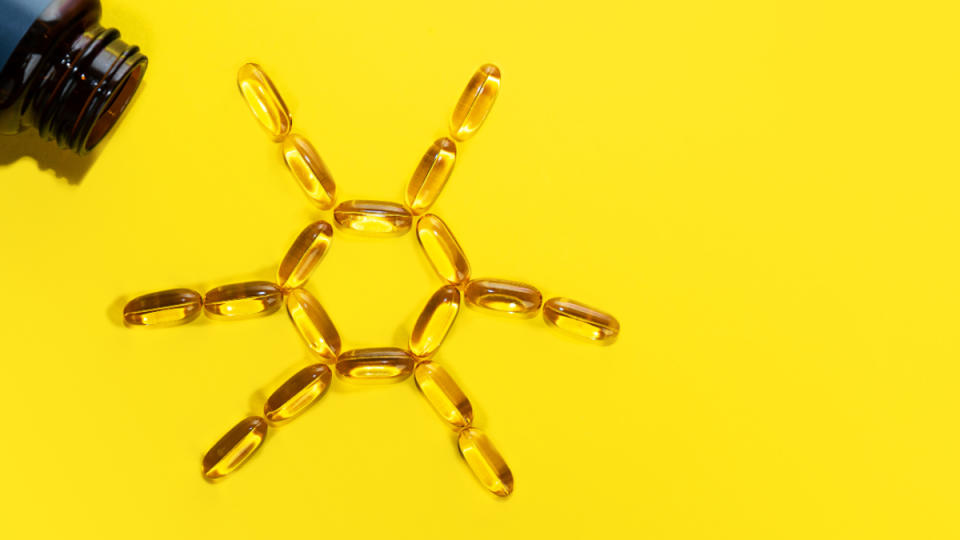Tired and Blue During Winter’s Dreary Days? Top MD Says Vitamin D Can Help
During winter, when daylight hours are short and the chill keeps folks indoors, many of us feel a little less upbeat. But blue moods that linger can be a sign of seasonal affective disorder (SAD), a type of mood disorder that can drain your energy, dampen your spirits and disrupt your daily routine. Fortunately, you don't have to suffer through until spring. Supplementing with vitamin D for seasonal affective disorder can boost your joy and renew your vim and vigor. Here, find out what causes SAD, plus how natural remedies like vitamin D can help.
What is seasonal affective disorder?
Typically starting in late fall and easing with the arrival of spring, winter-pattern seasonal affective disorder can cause fatigue, mood swings, difficulty concentrating, depressed mood, anxiety, irritability, weight gain, carbohydrate cravings and overeating. It is more prevalent in colder climates (especially in northern regions like Canada and the Northern US) and affects up to 10% of people. Symptoms may start out mild and become more severe as the season progresses.
This significant shift in well-being is closely tied to the amount of natural light exposure people receive, explains Wendy Warner, MD, a functional medicine gynecologist in Langhorne, Pennsylvania, and co-author of Boosting Your Immunity for Dummies. “Often people don't realize right away that the moodiness they’re experiencing is light-dependent,” says Dr. Warner. “They might think initially it's tied to the holidays and the time of year.”
SAD can and does affect any age group, and women are more prone to the condition than men. People with a history of mood disorders are also more at risk, and family history can play a role in the prevalence, too, says Dr. Warner.

Related: This Arctic Herb Shows Great Promise In Treating Tiredness and Depression, Says Top Psychiatrist
What causes seasonal affective disorder?
While the exact cause of SAD is not entirely understood, one key factor is how sunlight (or the lack thereof) influences brain chemicals. That's especially true when it comes to serotonin, a neurotransmitter crucial for regulating mood. As Dr. Warner explains, "in people with SAD, serotonin levels may drop during winter." (Click through to discover serotonin-boosting foods.)
Additionally, the sleep-regulating hormone melatonin is known to be adversely affected by the longer nights of winter. "Those with SAD often have extended melatonin release, leading to disrupted sleep patterns," Dr. Warner says. This can leave you feeling sleepy when you should be awake or cause difficulty sleeping at night (which can worsen your mood).
Moreover, SAD can interfere with the body's circadian rhythm, or your internal clock governing wakefulness and sleep. "The shorter days in winter can alter these rhythms, leading to problems with both sleep and mood regulation," explains Dr. Warner. The result: irritability, exhaustion and feeling out of sorts.
Vitamin D for seasonal affective disorder
The good news: You don't have to spend all winter feeling glum and run down. A critical aspect of managing seasonal affective disorder is understanding how the body uses vitamin D, a nutrient linked to serotonin production. The body naturally produces vitamin D when sunlight strikes skin. However, the scarcity of sunlight during winter months can lead to a significant reduction in this essential nutrient, explains Dr. Warner.
"When there's plenty of sunlight, our body produces vitamin D naturally," says Dr. Warner. "But in winter, the lack of sunlight leads to decreased vitamin D production, which can affect serotonin levels. While no one is 100 % sure why vitamin D helps with SAD, its role in increasing serotonin levels is the main impact,” says Dr. Warner.

She adds that vitamin D is known to have other beneficial effects, too, including helping the body absorb and retain calcium and phosphorus (crucial for building bone), controlling infections and reducing inflammation. It also plays a role in regulating the "feel-good" hormone dopamine.
A review of studies found that folks with seasonal affective disorder often have lower levels of vitamin D during the winter months. It showed that, in general, people with low levels of vitamin D are at a greater risk of experiencing depression.
Testing for vitamin D
Given the link between this key nutrient and SAD, it's no surprise that vitamin D supplements can go a long way toward reducing seasonal affective disorder symptoms. But first, it's essential to determine your vitamin D levels. This can easily be done through a blood test for 25-hydroxy vitamin D, typically prescribed by a healthcare provider. Alternatively, you can consider a home vitamin D test kit, which involves a simple finger prick to get a blood sample that you mail away for results. One to try: CVS Health At Home Vitamin D Test Kit (Buy from CVS, $39.99).
For general health, including maintaining bone strength, a vitamin D level within the range of 25 to 80 ng/dL is considered optimal. However, when it comes to addressing seasonal affective disorder, Dr. Warner suggests aiming for a vitamin D level between 50 and 80 ng/dL.
While it's best to talk to your doctor before supplementing, Dr. Warner says most people with low vitamin D levels can combat it by taking 5,000 IU of D3 daily from October through March. She recommends Metagenics D3 5,000 + K (Buy from Amazon, $30.53). After about a month or two of supplementing, Dr. Warner says most people start feeling better.
Concerned about overdoing it? Dr. Warner reassures that vitamin D overdoses are quite rare. "There's a theoretical risk of liver damage, but it's just that — theoretical. In my practice, I've yet to see such a case," she says.
More ways to outsmart SAD
Vitamin D is one of the best natural treatment options when it comes to fending off symptoms of seasonal affective disorder. But it's not the only remedy. Here, four more easy tricks keep your mood and energy up all season long:
1. Savor a scramble
Start a chilly winter day with a hearty plate of scrambled eggs and you'll be fending off SAD with every delicious bite. That's because foods like egg yolks, soy milk, fortified dairy milk and mushrooms are rich in mood-lifting vitamin D, which tames SAD.
Don't overlook seafood sources, too. Oily fish like salmon, mackerel and sardines are not only rich in vitamin D, they also contain omega-3 fatty acids that are beneficial for the brain's emotional regulation. Other smart sources of omegas include walnuts, chia seeds and canola oil. (Click through to learn how omega-3 fatty acids can improve your night vision during dark winter days, too.)

2. Keep your lights on longer
A simple trick to fend off SAD: Keeping your home well-lit. Dr. Warner suggests keeping indoor lights bright during the day and not turning them off too early in the evening. “Maintain good lighting in your home until an hour or two before bedtime, then gradually start winding down. This helps signal to your body that it's nearing time to sleep," she advises. This syncs your circadian rhythm, which is vital for mood and sleep regulation when daytime light is scarce.
3. Try light therapy
While a brightly lit home is a great start toward reducing SAD symptoms, you can boost the benefit with a little light therapy. Dr. Warner recommends using a light box, which mimics natural sunlight, starting from early fall.
“Sit in front of the light box for at least 30 minutes each morning, keeping it 12 to 24 inches away at eye level or higher," Dr. Warner advises. "Make sure the light reaches your eyes, as it helps stabilize melatonin production at night." The ideal time to use a light box is before 8 a.m., which better helps regulate your body clock. You can soak up the light while sipping your morning coffee, catching up on emails or doing a crossword puzzle. One to try: Verilux HappyLight Luxe Light Therapy Lamp (Buy from Amazon, $69.99).

4. Supplement with melatonin
In addition to taking vitamin D for SAD in the morning, trying supplementing with melatonin in the evening. By addressing both the mood and sleep-related aspects of SAD, this combination can ease symptoms during the winter months. “Melatonin is not just for sleep,” Dr. Warner adds. “It actually acts as an antioxidant that also provides mood benefits.” She recommends Symphony Natural Health 0.3 mg Plant Melatonin (Buy from Amazon, $17.99). (Not interested in melatonin? Click through to learn how the holy basil herb improves sleep, too.)
Vitamin D for SAD success story: Nan Greindl, 58

Nan Greindl, 58, sighed, rubbing her eyes as she watched the sun come up for yet another morning. She had been up all night after experiencing a panic attack stronger than anything she had ever felt before. But sadly for Nan, that was becoming the norm.
Since her early 40s, Nan noticed that when the days of the year began getting shorter, she would suffer from anxiety, lethargy and a struggle to focus and enjoy the things that used to make her happy.
But this latest panic attack made it clear that something had to be done. So Nan made an appointment with her primary care physician. After asking Nan some questions, her doctor wrote a prescription for an antidepressant and sent Nan on her way.
I don’t want help with the symptoms — I want a cure for the cause! Nan fretted, feeling frustrated and helpless as she left. I’m happily married, I love my job, have no health issues…why is this happening to me?
Prescription meds didn't work for Nan
As it turned out, the side effects from the antidepressants she had been prescribed made Nan feel even worse, zonking her out whenever she would take them. Feeling desperate, Nan knew she had to find someone to help.
So she got to work looking for a new primary care physician and eventually found a doctor she trusted. The doctor's first order of business was to ask Nan a battery of questions about her mental well-being, with one question being of particular interest: “Do your panic attacks happen at a certain time of the day, or get worse during certain times of the year?”
As Nan explained, they did — when the days started to get darker each winter in her home of Topsham, Maine.
“You have seasonal affective disorder,” her doctor said. She explained that SAD is a mood disorder characterized by depression and anxiety that occurs at the same time every year, particularly in climates where there is less sunlight. Then, Nan's physician asked her a question no doctor had ever asked her before: “Do you take vitamin D?”

How vitamin D eased Nan's seasonal affective disorder
When Nan answered that she did not, her doctor had her levels of the "sunshine vitamin" checked. Nan was indeed deficient in the vitamin, which can cause fatigue, muscle pain, bone weakness and mood changes like depression and anxiety. Nan also learned that studies link low vitamin D levels with a greater risk of SAD. The vitamin plays a key role in helping the brain synthesize the mood-regulating hormones serotonin and dopamine.
Startled, Nan bought an over-the-counter 5,000 IUs vitamin D3 supplement and began taking it every morning. Over the course of a few months and after over a decade of struggling, Nan was shocked to notice that her panic attacks and depression were dissipating. And as the deeper part of winter arrived, she upped her dose to 10,000 IUs.
“I feel great now!” says Nan, who is now free of panic attacks and SAD. “I no longer dread the dark, shorter days and haven’t had a panic attack in five years. My depression and anxiety are completely gone. I’m now taking my vitamin D3 all year round. I’m so glad I was able to find a natural, inexpensive way to cure my SAD!”
For more natural ways to lift your mood:
Top Doctor: This Natural Extract May Restore Your Mood, Mental Focus and Motivation
Serotonin Boosting Foods Take Your Mood From Blah To Bliss — In 30 Minutes or Less!
The Best DHEA Supplements To Speed Weight Loss and Boost Mood
This content is not a substitute for professional medical advice or diagnosis. Always consult your physician before pursuing any treatment plan.
First For Women aims to feature only the best products and services. We update when possible, but deals expire and prices can change. If you buy something via one of our links, we may earn a commission. Questions? Reach us at [email protected]
